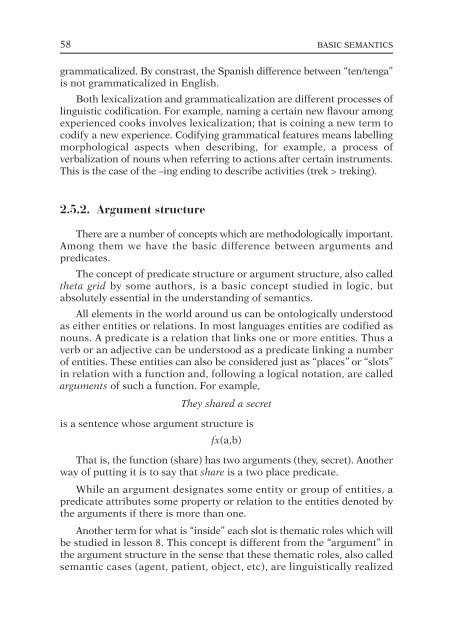Semantics
Create successful ePaper yourself
Turn your PDF publications into a flip-book with our unique Google optimized e-Paper software.
58 BASIC SEMANTICS<br />
grammaticalized. By constrast, the Spanish difference between “ten/tenga”<br />
is not grammaticalized in English.<br />
Both lexicalization and grammaticalization are different processes of<br />
linguistic codification. For example, naming a certain new flavour among<br />
experienced cooks involves lexicalization; that is coining a new term to<br />
codify a new experience. Codifying grammatical features means labelling<br />
morphological aspects when describing, for example, a process of<br />
verbalization of nouns when referring to actions after certain instruments.<br />
This is the case of the –ing ending to describe activities (trek > treking).<br />
2.5.2. Argument structure<br />
There are a number of concepts which are methodologically important.<br />
Among them we have the basic difference between arguments and<br />
predicates.<br />
The concept of predicate structure or argument structure, also called<br />
theta grid by some authors, is a basic concept studied in logic, but<br />
absolutely essential in the understanding of semantics.<br />
All elements in the world around us can be ontologically understood<br />
as either entities or relations. In most languages entities are codified as<br />
nouns. A predicate is a relation that links one or more entities. Thus a<br />
verb or an adjective can be understood as a predicate linking a number<br />
of entities. These entities can also be considered just as “places” or “slots”<br />
in relation with a function and, following a logical notation, are called<br />
arguments of such a function. For example,<br />
They shared a secret<br />
is a sentence whose argument structure is<br />
fx(a,b)<br />
That is, the function (share) has two arguments (they, secret). Another<br />
way of putting it is to say that share is a two place predicate.<br />
While an argument designates some entity or group of entities, a<br />
predicate attributes some property or relation to the entities denoted by<br />
the arguments if there is more than one.<br />
Another term for what is “inside” each slot is thematic roles which will<br />
be studied in lesson 8. This concept is different from the “argument” in<br />
the argument structure in the sense that these thematic roles, also called<br />
semantic cases (agent, patient, object, etc), are linguistically realized



